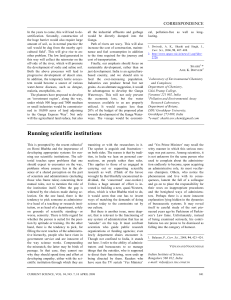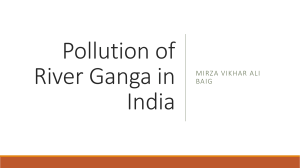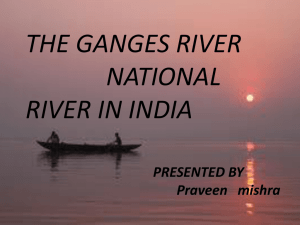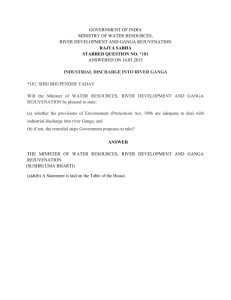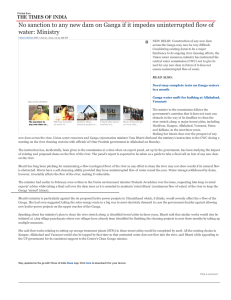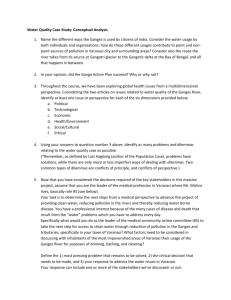Ganges River: Geography, History, Pollution & Cleaning Efforts
advertisement
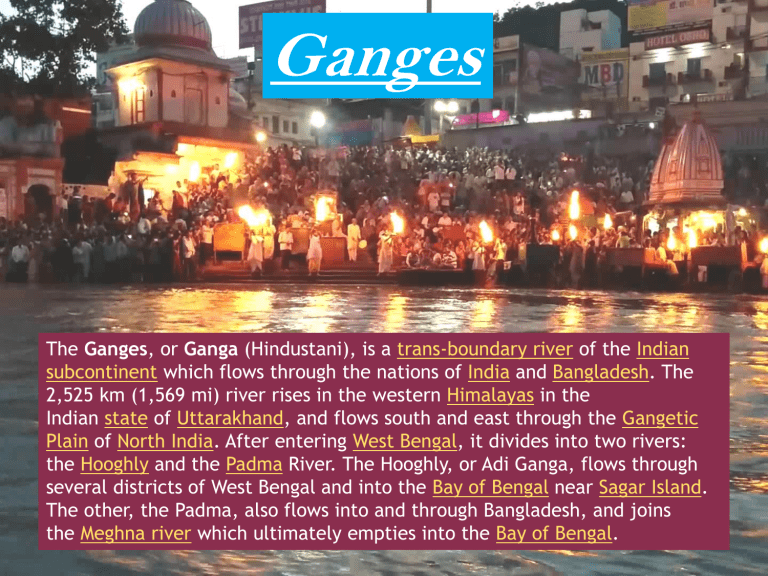
Ganges The Ganges, or Ganga (Hindustani), is a trans-boundary river of the Indian subcontinent which flows through the nations of India and Bangladesh. The 2,525 km (1,569 mi) river rises in the western Himalayas in the Indian state of Uttarakhand, and flows south and east through the Gangetic Plain of North India. After entering West Bengal, it divides into two rivers: the Hooghly and the Padma River. The Hooghly, or Adi Ganga, flows through several districts of West Bengal and into the Bay of Bengal near Sagar Island. The other, the Padma, also flows into and through Bangladesh, and joins the Meghna river which ultimately empties into the Bay of Bengal. The Ganges is one of the major rivers of the Indian subcontinent, flowing east through the Gangetic Plain of northern India into Bangladesh. The 2,510 km (1,560 mi) river rises in the western Himalayas in the Uttarakhand state of India, and drains into the Sunderbans delta in the Bay of Bengal During the early Vedic Ages, the Indus and the Saraswati River were the chief rivers, not the Ganges. Possibly the first Westerner to mention the name of Ganges was Megasthenese. The story of the Ganges, from her source to the sea, from old times to new, is the story of India`s civilization and culture, of the rise and fall of empires,of great and proud cities, of adventures of man. Before the late 12th century the Bhagirathi-Hooghly distributary was the main channel of the Ganges and the Padma was only a minor spill-channel. The main flow of the river reached the sea not via the modern Hooghly River but rather by the Adi Ganga. Between the 12th and 16th centuries the Bhagirathi-Hooghly and Padma channels were more or less equally significant. After the 16th century the Padma grew to become the main channel of the Ganges In hindu tradition: •It has long been considered a holy river by Hindus and worshiped as the goddess Ganga in Hinduism. *For Hindus in India, the Ganges is not just a river but a mother, a goddess, a tradition, a culture and much more Ganga River is also said to be the river of supreme Lord Rama and also called "Ram Ganga" as there is a belief Lord Rama promised while Ganges emerged from his feet that, when He will appear on earth as Lord Rama will reside on the banks of Ganga and her tributaries. Lord Ram then appeared in Ayodhya which is on the banks of Saryu Ganga River, when he went to Janakpuri he crossed River Ganga in Haridwar. *Some Hindus also believe life is incomplete without taking a bath in Ganges at least once in their lives. Many Hindu families keep a vial of water from the Ganges in their house. In our history: * It has also been important historically: many former provincial or imperial capitals (such as Patliputra, Kannauj, Kara, Allahabad, Murshidabad,and Calcutta) have been located on its banks. * The story of the Ganges, from her source to the sea, from old times to new, is the story of India`s civilization and culture, of the rise and fall of empires, of great and proud cities, of adventures of man. IN today's world and economic significance: * The Ganges Basin drains 1,000,000-square-kilometre (390,000 sq mi) and supports one of the world`s highest densities of humans. * The water used for agriculture in the Gangetic plains comes from the Ganges. Chief crops cultivated in the region include wheat, lentils, rice, potatoes, sugarcane and oil seeds. Jute, legumes, mustard, sesame, and chillies are also grown along the banks of the river. *Almost half of the population of India lives on one-third of the landscape within 500 km of the Himalayan range along the Gangetic plains and depends on the River Ganges. *The Ganges also contributes to the fishing industry. During summers, numerous adventure activities, including river rafting is done in the suitable stretches of the river. *Many stretches of the river are used as navigation system for transporting goods and people. * The alaknanda river meets the dhauliganga river at vishnuprayag, the nandakini river at nandprayag, the pindar river at karnaprayag, and the mandakini river at rudraprayag And finally the bhagirathi river at devprayag, to form the mainstream, the ganges. * The bhagirathi is the source stream; it rises at the foot of gangotri glacier, at gaumukh, at an elevation of 3,892 m (12,769 ft). The headwaters of the alaknanda are formed By snowmelt from such peaks as nanda devi, trisul, and kamet. *The major cities along the River Ganges are Haridwar, Moradabad, Rampur, Allahabad, Kanpur, Patna, Varanasi and Raj Shahi. The Ganges Delta is at the Bay of Bengal, Bangladesh. *Joined by numerous rivers such as the Kosi, Son, Gandaki and Ghaghra, the Ganges forms a formidable current in the stretch between Allahabad and Malda in West Bengal. On its way it passes the towns of Kanpur, Soron, Kannauj, Allahabad, Varanasi, Patna, Ghazipur, Bhagalpur, Mirzapur, Ballia, Buxar, Saidpur, and Chunar. At Bhagalpur, the river meanders past the Rajmahal Hills, and begins to run south Causes of pollution: 1)Industrial Waste – There are a large number of industries on the bank of the Ganges in cities like Patna, Kanpur, Varanasi and Allahabad. Numerous tanneries, slaughterhouses,textile miles, hospitals, chemical plants and distilleries dump untreated wastes into the river resulting in polluting the river. Out of the total volume of effluent reaching the river, twelve percent is contributed by the industries. Municipal sewage constitutes 80 per cent by volume of the total waste dumped into the Ganga, and industries contribute about 15 percent. The majority of the Ganga pollution is organic waste, sewage, trash, food, and human and animal remains. . A total of 146 industries are reported to be located along the river Ganga between Rishikesh and Prayagraj. 144 of these are in Uttar Pradesh (U.P.) and 2 in Uttrakhand. The major polluting industries on the Ganga are the leather industries, especially near Kanpur, which use large amounts of Chromium and other toxic chemical waste, and much of it finds its into the meager flow of the Ganga. 2)Human Waste – The Ganges flows through 52 cities and 48 towns. The domestic water used by the population in these cities and towns adds to the pollution of the river. 3)Religious Traditions – More than 70 million people bathe in the Ganges to during the festive season. Food, leaves, flowers, diyas and other wastes are left in the Ganges that adds to its pollution. According to Hindu tradition, if a deceased person is cremated on the banks of the Ganges then that would bring instant salvation. This results in thousands of bodies being cremated on the banks of the river every year, many of which are only half-burnt, thus, adding to the pollution. Diseases caused due to gange's pollution: * Recent water samples collected in Varanasi revealed fecalcoliform counts of about 50,000 bacteria per 100 milliliters of water, 10,000% higher than the government standard for safe river bathing. The result of this pollution is an array of water-borne diseases including cholera, hepatitis, typhoid and amoebic dysentery. An estimated 80% of all health problems and one-third of deaths in India are attributable to water-borne diseases. Action taken to clean ganges Over the years, several programmes have been launched and steps taken to clean the river but these actions hardly had any impact of the pollution levels. On 14th January 1986, the then Prime Minister Rajeev Gandhi, launched The Ganges Action Plan (GAP). The primary objective of GAP consists of improving the quality of water by treatment and interception of domestic sewage. This model was extended by the Government of India with various modifications through National River Action Plan (NRAP). On 20th February 2009, the Central Government established National River Ganga Basin Authority (NRGBA) under Sec 3 of the Environment Protection Act 1986. The Ganges was declared as the ‘National River of India,’ under this. The World Bank approved $1 billion funds for the NRGBA in 2011. The Supreme Court has also been doing its bit by directing the government and concerned authorities to take appropriate action towards relocation and closure of industries thatcause pollution by dumping waste. The stretch between Gaumukhi and Uttarkashi was declared as an Eco-sensitive zone by the government in 2010. About Ganga Action Plan I The Ganga rises in the Garhwal Himalaya from the Gangotri Glacier, some 4100 meters above the sea level under the name of Bhagirathi.The river flows through the Himalayas till another two streams, the Mandakani and the Alakhnanda join it at Devprayag. It is below this confluence that the river is known as the Ganga proper. The Ganga Basin which is the largest river basin of the country houses about 40% population of India. The river after traversing a distance of 2525 kms. from its source, meets the Bay of Bengal at Ganga Sagar in West Bengal. During the course of its journey from the hills to the sea, municipal sewage from large urban centres, trade effluents from industries and polluting waste from several other non-point sources are discharged into the river resulting in its pollution. Objectives of Ganga Action Plan I : At the time of launching, the main objective of GAP was to improve the water quality of Ganga to acceptable standards by preventing the pollution load reaching the river. However, as decided in a meeting of the Monitoring Committee in June, 1987 under the Chairmanship of Prof. M. G. K. Menon, then Member, Planning Commission, the objective of GAP was recast as restoring the river water quality to the 'Bathing Class' standard which is as follows: About Ganga Action Plan II The program of river cleaning was extended to other major rivers of the country under two separate schemes of GAP Phase - II and the National River Conservation Plan (NRCP). Yamuna and Gomati Action Plans were approved in April 1993 under Ganga Action Plan Phase - II. Programs of other major rivers were subsequently approved in 1995 under NRCP. After launching of NRCP in 1995, it was decided to merge GAP II with NRCP. A notification of this effect was issued on 05.12.1996. Objectives of Ganga Action Plan II : The Ganga Action Plan besides aiming at improving the water quality of river Ganga is to serve as a model to demostrate the methodology for improving the water quality of other polluted rivers. Though the river water quality of Ganga has shown discernible improvement, the full impact of the action plan would be visible when the left out works in the 25 class I cities and the works in other class II and class III towns along the river Ganga are taken up. The important tributaries of river Ganga like,Yamuna,Gomati and Damodar which directly discharge into the river Ganga are heavily polluted and are taken up for pollution abatement Programmes. Objectives of Ganga Action Plan II : For this purpose, the second phase of Ganga Action Plan was started in stages between 1993 & 1996. Both Central & State Government Provided help and had equal Share that is 50:50 in the working of Ganga Action Plan (Phase II). After April 1997 Central Government took the full responsibility of this project & sanctioned the total cost Under Ganga Action Plan.Other river conservation plans for Yamuna,Gomati and Damodar have also been accepted and the goverment has sanctionedd Rs.2285.48 crore for the same. This money will help in statrting 441 projects in 95 cities under the plan. Implementation of the plan finally commenced w.e.f. 1.4.2001. The funding pattern was changed to 70:30 between centre and state subsequently. Towns Covered In Ganga Action Plan II ★ ‘Namami Gange Programme’, is an Integrated Conservation Mission, approved as ‘Flagship Programme’ by the Union Government in June 2014 with budget outlay of Rs.20,000 Crore to accomplish the twin objectives of effective abatement of pollution, conservation and rejuvenation of National River Ganga. ★ Its implementation has been divided into Entry-Level Activities (for immediate visible impact) Medium-Term Activities (to be implemented within 5 years of time frame) and Long-Term Activities (to be implemented within 10 years). The key achievements under Namami Gange programme are:1. Creating Sewerage Treatment Capacity:- 63 sewerage management projects under implementation in the States of Uttarakhand,Uttar Pradesh, Bihar, Jharkhand and West Bengal. 12 new sewerage management Projects Launched in these states. The key achievements under Namami Gange programme are:Work is under construction for creating Sewerage capacity of 1187.33 (MLD).Hybrid Annuity PPP Model based two projects has been initiated for Jagjeetpur, Haridwar and Ramanna,Varanasi. 2. Creating River-Front Development:-28 River-Front Development projects and 33 Entry level Projects for construction, modernization and renovation of 182 Ghats and 118 crematoria has been initiated. 3. River Surface Cleaning:-River Surface cleaning for collection of floating solid waste from the surface of the Ghats and River and its disposal are afoot and pushed into service at 11 locations. 4. Bio-Diversity Conservation:- Several Bio-Diversity conservation projects are namely: Biodiversity Conservation and Ganga Rejuvenation, Fish and Fishery Conservation in Ganga River, Ganges River Dolphin Conservation Education Programme has been initiated. 5 Bio-Diversity center’s at Dehradun, Narora, Allahabad,Varanasi and Barrackpore has been developed for restoration of identified priority species. The key achievements under Namami Gange programme are:5.Afforestation:- Forestry interventions for Ganga through Wildlife Institute of India; Central Inland Fisheries Research Institute and Centre for Environment Education has been initiated.Forestry interventions for Ganga has been executed as per the Detailed Project Report prepared by Forest Research Institute, Dehradun for a period of 5 years (2016-2021) at project cost of Rs.2300 Crores. Work has been commenced in 7 districts of Uttarakahnd for medicinal plants. 6. Public Awareness:- A series of activities such as events, workshops, seminars and conferences and numerous IEC activities were organized to make a strong pitch for public outreach and community participation in the programme.Various awareness activities through rallies, campaigns, exhibitions, shram daan, cleanliness drives, competitions, plantation drives and development and distribution of resource materials were organized and for wider publicity the mass mediums such as TV/Radio, print media advertisements, advertorials, featured articles and advertorials were published. Gange Theme song was released widely and played on digital media to enhance the visibility of the programme.
